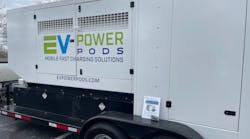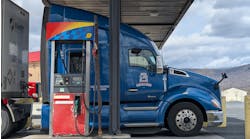Electrification is advancing—among smaller commercial and delivery fleets especially—so the pressure is mounting on power grids everywhere in the U.S. to supply the juice necessary to charge all these new electric vehicles. Ambitions are high, actual locations to charge en masse? TBD. Enter some mobile solutions that offer alternatives short of having to dig in the ground, pour concrete, and arrange complicated and costly connections to the grid for fixed EV chargers.
In most emerging markets, creative companies fill in the gaps until a nascent technology successfully penetrates the marketplace. Trucking stakeholders are debating the problem, but the power grid and charging infrastructure won't be ready in most places, even accounting for a few more years of time and progress. Companies like New York-based Ideanomics, which is focused on driving EV adoption for commercial fleets, and Evansville, Indiana-based EnviroCharge are good to go, however, with the EV PowerPod, which is what EnviroCharge calls a breakthrough “gap-to-grid” solution, and Ideanomics’ prototype WAVE Rapid device that resembles a plain-old cargo container.
Mark Miller said he believes EnviroCharge might have even coined the phrase, "gap to grid."
Fleets, especially those headquartered rurally, already are asking him where they’ll get the power, said Miller, who is the chief revenue officer at EnviroCharge, the division of EnviroGen Technologies that markets the EV PowerPod. The mobile trailer version of the product (there also is a deployable static version and a third that is fixed-mounted on its own small truck) can be towed by trucks or pickups. All versions are equipped with Level 3 DC fast chargers and are completely independent of the grid because they generate power running off traditional fuels—liquid propane, compressed natural gas, and plain-old diesel—not dissimilar to the generator anyone can purchase at Lowe's or Home Depot as a power backup for their home or business.
See also: Fleets in the 'messy middle' can chew gum and walk at the same time
These units have standard CCS1 charge connectors and can accommodate all classes of current electric vehicles—from the largest Class 8s like Volvo's VNR Electric or Kenworth’s T680 to smaller Classes 2-6 commercial EVs like those in the ride-and-drive area at the Indiana Convention Center in early March in downtown Indianapolis during NTEA's expansive Work Truck Week 2023.
That’s where FleetOwner bumped into Miller, who accompanied a propane-fueled EV PowerPod to Indy to promote the units to fleet operators attending the show for work truckers. He also was coordinating recharging for some of the e-work trucks in the show’s ride-and-drive area, which showcased EVs from Blue Arc, Via, Workhorse, Motiv, Lion Electric, GM’s BrightDrop, and several others.
“We go where they need us,” Miller emphasized in a follow-up interview after the show. “Every time, I have a conversation with a fleet or an OEM, [they] test me with these particular questions. This is gap to grid—I’d say we coined that. Where this is used most is the end user; they have contacted the power company, and the power company has said the power is available but that it’s going be an extended time before that infrastructure can be built.”
“The big push in this country," he emphasized, "is to provide rural-based EV charging, because that’s one of the most difficult things for power companies to provide, the transmission capacity" in out-of-the-way places.
Solutions for carriers leasing their land
Miller also made a point to mention fleets that don’t own the property on which their headquarters or terminals are located.
Many fleets that want to electrify also lease their land and buildings—and it’s often a complicated proposition for them, as the tenant, to negotiate with a landlord to allow for the breaking of ground, the pouring of concrete, and the installation of fixed permanent charging, not to mention the related infrastructure and connections to the grid itself. Also, the next tenant might not want or need that infrastructure, so there's little incentive for a lessor to cooperate.
“If you operate the fleet out of that building, who is going to pay for that charging infrastructure?” he also asked. But that’s where EV PowerPods and other “go-between-grid” solutions can fill another need.
There are other mobile chargers in the marketplace, but many aren't fast chargers (which can bring some EVs to 80% in 20 to 30 minutes) and don't fill the needs of fleets that operate multiple EVs. Other players like Ideanomics, Heliox, Gilbarco Veeder-Root, SparkCharge, Mobi, EV Safe Charge, and Lightning eMotors' Lightning Mobile have entered the on-the-go charging space. However, many are geared more toward passenger cars or the lightest commercial EVs.
See also: Utah PaperBox to deploy Volvo VNR Electric Class 8
For example, Ideanomics touts its prototype WAVE Rapid high-powered device that looks like a shipping container as another highly viable mobile solution.
Hands-free, with no moving parts, Ideanomics said in a release that the WAVE Rapid (like the EV Power Pod) is suited for leased facilities, where tenants don’t want to or aren’t permitted to install fixed charging infrastructure. Ideanomics also suggests that WAVE Rapid is appropriate for fleet depots (also often leased facilities), offroad locations, and semi-public locations. A companion to its WAVE device aimed more widely for mass-transit vehicles, Ideanomics expects WAVE Rapid to go into production later this year and be marketed to parcel delivery and port operations (remember, it looks like a shipping container like what would sit on the back of any drayage trailer) market, Jan Freimann, senior VP at Ideanomics Energy, said in an interview with FleetOwner.
Freimann said power aboard the prototype peaks at 400kW per port, and there can be up to 20 DC charging dispensers aboard. According to Ideanomics Energy materials on the WAVE Rapid, the containers are preassembled off-site and can be configured with a variety of charger types and power levels and offer upfront savings because they avoid construction costs and utility connection fees. The WAVE Rapid is slated to go into production later this year, Freimann said.
Meanwhile, the EV PowerPod, which is heavier duty than most mobile charging platforms, can be described as emergent. A total of 12 PowerPods are “on the street” with customers, according to Miller, eight that are propane-fueled, three that run on CNG, and one that burns diesel, which EnviroCharge also uses as a selling point for fleets dabbling in electrification but that almost exclusively run diesel-burning power units. About another 32 more PowerPods are on order with the manufacturer, 75% of which burn propane to run the onboard EV charging, Miller said.
That’s also purposeful, he added, because liquid propane is common and widely available and used in rural areas where electrical infrastructure might be less capable and scarcely available to power electric vehicles. The CNG-powered trailers are popular with fleets that also run CNG-fueled tractors, he added, and have natural-gas fueling infrastructure in place to fill both their trucks and the EV PowerPods they purchase.
“A lot of fleets have already done the compressed natural gas infrastructure,” Miller said.
Six other EV PowerPods are in production; about 75% of those will run on propane. The company, Miller said, plans to market and a sell charging trailers that will run on hydrogen, which itself has emerged as a transportation fuel and drives manufacturers such as Hyzon, Volvo, Nikola, and Daimler, to name a few.
“We want to add that to our fuel group,” Miller said of hydrogen, but adding that propane and CNG PowerPods always will be part of EnviroCharge's product portfolio.
And mobile solutions themselves no matter the brand, he predicted, won’t ever go away, even if the grid is able to modernize and better serve electrified fleets everywhere. “After this is all said and done, and the grid catches up, we will still serve a purpose,” Miller added. “Our trailers are built to be a longer-term solution. We’re not just a quick fix. We’re here for the long haul. We want to be a long-term solution provider.”
This is the first of three stories this week on electric vehicle charging solutions and strategies. Look for the other two on FleetOwner.com later this week.







